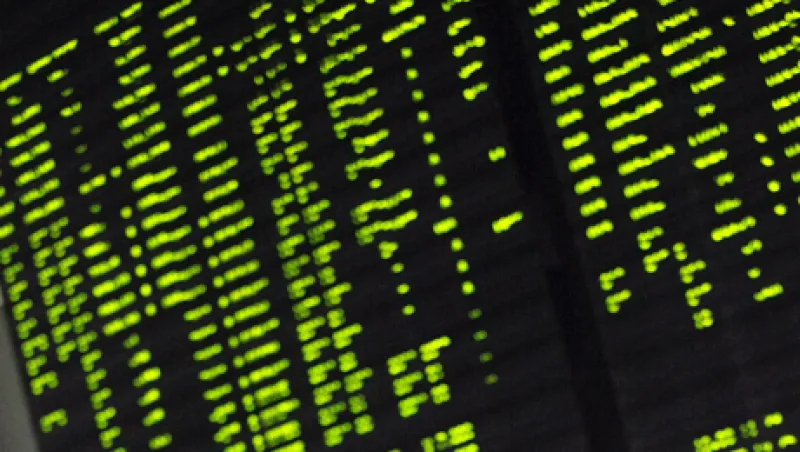The soaring volatility of the equity market has created demand for a new breed of exchange-traded funds and notes. Those notes have lowered transaction costs but may be building a premium for underlying assets, according to Henry Chien, an analyst with financial researcher The TABB Group.
The equity market endured one of its most volatile years ever in 2011. Twenty components of the S&P 500 fell 20 percent or more, compared with 11 in 2010 and 15 in 2009, according to Bloomberg data. Overall, stock price changes were twice the five-decade average. The great irony is that those movements did not seem to lead anywhere. The S&P 500 was essentially flat for the year, slipping 0.04 percent to 1,257.60 — the first zero percent annual performance in 60 years.
Yet for certain traders, the volatility itself was the story. Sophisticated hedge funds and individual investors poured money into a relatively new class of derivatives designed specifically to take advantage of the wild price swings that have characterized the equity markets in recent years. For those traders, an emphasis on individual companies has been replaced by a focus on indexes and asset classes, with sentiment driven on a daily basis by macro news such as geopolitical events, the U.S. fiscal outlook and the debt crisis in Europe.
Those volatility traders have poured money into a new class of exchange-traded funds and notes linked to the CBOE’s Market Volatility index, or VIX. Also called the Fear index, the VIX measures investor expectations for the volatility of the S&P 500 over the next 30 days. Since 2006, the market for exchange traded products linked to the VIX has logged a five-year compound annual growth rate of 131 percent, according to Chien. The daily notional value of those products — which includes VIX options, futures, exchange-traded funds and exchange-traded notes — is now $4.1 billion, up from $52 million in 2006, according to Chien. The exchange-traded products including ETFs and ETNs account for $1.18 billion of that total, up from $492 million in 2010 and $55 million in 2009.
Like other ETFs, the VIX products are funds that are listed on an exchange and can be traded throughout the day like stocks. Instead of holding individual equities — which is what many ETFs do — the VIX ETFs own options and futures linked to the VIX index. The VIX ETNs own debt related to those indexes.
The VIX related products have taken off since Barclays introduced the first exchange-traded product linked to the index in January 2009. The iPath S&P 500 VIX Short-Term Futures ETN (VXX) was designed to track the S&P 500 VIX Short-Term Futures index. It is the largest product in the market, with $730 million in asset under management as of the end of 2011.
The appeal of these products is similar to that of other ETFs and ETNs: lower costs and ease of use. “It is so much easier to get access to volatility through exchange-traded products, and it’s cheaper,” Chien says. The alternative approach would be a complicated hedging strategy that involved several aspects of VIX options, such as their volatility, the price of their underlying assets, their expiration and interest rates, Chien said. The transaction costs for those alternatives is much higher than simply buying an instrument that combines all of those elements.
The growth of this market has created arbitrage opportunities, too. Traders looking to capitalize on volatility can buy relatively cheap exposure in the VIX market and sell exposure in the broader options and futures market, Chien said.
The growth of ETFs has raised questions about their impact on the market, though. Some critics say ETFs are driving volatility and shaping the value of their underlying assets, instead of merely reflecting them. Those questions have been raised in Senate hearings and are the subject of review by regulators in the U.S. and Europe. Chien said some of those dynamics might be at work in the volatility market. Chien, who recently studied the impact of volatility funds and notes, said there was no evidence that the products had an adverse impact on the broader financial market. But he did say that they might have an impact on a narrower slice of the market related to volatility trading itself. “VIX ETPs may be influencing the price of the index the products are designed to track,” he said.
Specifically, VIX ETPs might boost contango, a condition that occurs when the price of a commodity in the futures market is higher than the price in the spot market. The ETPs are meant to be held for only a short period of time. Otherwise, they lose value. That means there is an ever-higher level of contracts rolling into the next month in the futures market. “The net effect is that you pay a premium for the forward contract because there is so much demand. It puts upward pressure on the second forward-contract month and downward pressure on the first month,” Chien says. “In practice, ETPs likely steepen the contango of the VIX futures curve.”
The research shows that ETFs and ETNS — while lowering transaction costs and boosting flexibility for investors — might be imposing hidden costs elsewhere in the market.






